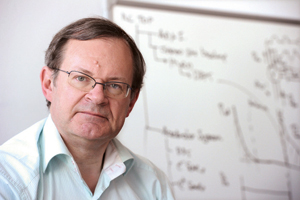In June, Brian Foster will take up his work at DESY and University of Hamburg as a joint professor for experimental physics, with a focus on accelerators for very high energies. He is one of eight professors who won a Humboldt professorship this year, the most outstanding research prize in Germany, endowed with 5 million Euros for five years.
Foster will engage in several research fields, covering the present, the future and perhaps the science fiction of accelerator physics: The most concrete project is to analyse the data of HERA‘s deep inelastic scattering processes. Foster is still in love with DESY’s electron-proton machine, which ceased operation in 2007. “I spent most of my career with HERA,” says former ZEUS detector spokesperson Foster. “The HERA data are very crucial for the analysis at the LHC, so someone has to make sure that the final results come out. Young people are naturally eager to analyse the Large Hadron Collider data but people like me can contribute to analysis in this way. I don’t have to worry about my career progression anymore.”
Also well-defined is a programme whose main goal is the optimisation of the accelerating gradient of ILC cavities, exploring several promising directions, for instance surface treatment and thin films. “We are facing a substantial programme of R&D. If we can improve the gradient to 45 megaelectronvolts per metre, perhaps 50, this would make superconducting technology very competitive with the Compact Linear Collider (CLIC) Study technique in terms of maximum gradient.”
Foster’s third field sounds a little more like science fiction: using the wakefields of a plasma to accelerate particles. Foster and his colleagues plan to use the electron beam of FLASH – a free-electron laser at DESY, using the same superconducting TESLA technology which should be used to realise the ILC – to check if it can be further accelerated by a plasma and is still usable for physics. “This programme is obviously nebulous at the moment, but here at DESY we have facilities that can make a unique contribution so it makes sense that we start such a programme here.”
Finally Foster has ambitious plans to inform the general public about his exciting scientific research. “I devote a lot of time to outreach,” says Foster, “and am enthusiastic about using the violin, and Einstein’s love of it, to reach new audiences.” He was buzzing with ideas, including commissioning new music to illustrate quarks and leptons and looking forward to the challenge of presenting his ideas in German as well as English.
But before planning the future and science fiction of particle physics, Brian Foster faces some very mundane problems. Starting officially in June, he still has duties to complete in Oxford until July, has to find a home in Hamburg and of course must begin to hire a team of people for his projects. For that, Foster will not only search in Hamburg, but also hopes to attract people from abroad. “I will work hard to enhance the strong ties between Oxford and DESY as well as building on current collaborations and starting new ones with colleagues inside and outside Germany.”
This story will also appear in the 9 June issue of DESY inForm.


Recent Comments